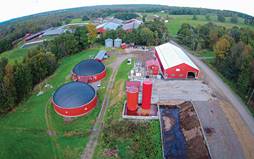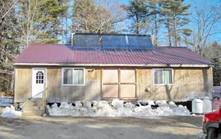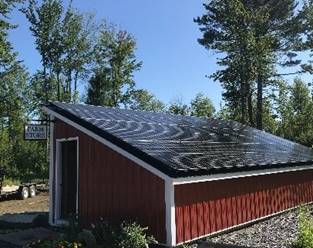DACF Home → Bureaus & Programs → Bureau of Agriculture → Agricultural Resource Development Division → Farmer Resources → Energy Efficiency and Renewable Energy Financial Resources
Energy Efficiency and Renewable Energy Financial Resources for Farms
Energy needs can be a major expense to a farm’s bottom line. Eliminating or upgrading inefficient equipment and investing in renewable energy resources can cut costs and help farms be more profitable. This webpage shares technical and financial resources and highlights energy efficiency and renewable energy opportunities that may help keep farms productive, reduce costs, and lessen environmental impacts.
On this page:
- USDA Rural Energy for America Program (REAP)
- Database of State Incentives for Renewables & Efficiency
- Efficiency Maine
- Agricultural Resource Development Division Loan Programs
- Examples of Energy Efficient Systems
USDA Rural Energy for America Program (REAP)
- Renewable Energy Systems and Energy Efficiency Improvement Guaranteed Loan and Grant Programs provide financial assistance to agricultural producers and rural small businesses to purchase, install, and construct renewable energy systems, make energy efficiency improvements to non-residential buildings and facilities, use renewable technologies that reduce energy consumption, and participate in energy audits and renewable energy development assistance.
- Several Maine farms have been awarded REAP grants in the last few years to purchase and install solar arrays at their businesses, saving money and offsetting their carbon footprint.
Database of State Incentives for Renewables & Efficiency
Find policies and incentives by entering your zip code at the Database of State Incentives for Renewables & Efficiency.
Efficiency Maine
The Efficiency Maine Trust provides programs to improve the efficiency of energy use and reduce greenhouse gases in Maine. Relevant programs are highlighted below.
- Agricultural Solutions Program offers rebates on:
- Milk Scroll Compressors: $200-$1,000 (incentive varies by system horsepower)
- Milk Vacuum Pump with Adjustable Speed Drive: $2,000-$5,000 (incentive varies by system horsepower)
- Potato Ventilation Fans (Adjustable Speed Drive or High Volume, Low Speed): $500 - $1,400 (incentive varies by system horsepower)
- Commercial and Industrial (C&I) Prescriptive Incentive Program offers businesses and manufacturers specific prescriptive measures for:
- Heating Systems: high-efficiency boilers, variable refrigerant flow systems, high-performance heat pumps, circulator pumps, and programmable thermostats.
- Lighting Solutions: replacing interior and exterior lighting and controls, and discounts on LEDs.
- Cooling Solutions: heat pumps and refrigerant flow systems.
- Commercial and Industrial (C&I) Custom Program offers free scoping audits for those eligible to develop a qualified project. It leverages private investment for projects costing between $10,000 - $1 million, or up to 50% of project costs.
- Technical assistance for:
- Distributed Energy Systems, which are systems behind the meter that reduce the consumption of grid-supplied electricity. These projects can include reciprocating engines, steam turbines, and anaerobic digesters.
- Thermal projects that reduce heating fuels consumption may include pipe insulation, heat recovery, condensate recovery, process steam reduction, HVAC controls and optimizations, heat exchangers, and recover boilers.
- Electrical projects that reduce electrical consumption and can include projects like compressed air systems and components, heat recovery, variable frequency drives, HVAC controls and optimization, chillers and refrigeration upgrades.
- Learn how Jasper Wyman & Son used the C&I Custom program to keep their wild blueberries cool with an energy-efficient refrigeration system.
Agricultural Resource Development Division Loan Programs
- Dairy Improvement Fund offers Maine dairy farms loans of up to $250,000 at 1% fixed interest rate for capital improvements.
- Agricultural Marketing Loan Fund offers Maine agricultural businesses loans of up to $250,000 at 5% fixed interest rate for capital improvements.
Examples of Energy Efficient Systems

Photo courtesy or Agri-Cycle Energy
Distributed Energy System: Anaerobic Digester, Exeter Agri-Energy, Exeter, Maine.
Bio-methane, or biogas, is produced when organic matter decomposes and is interchangeable with natural gas. When microorganisms digest organic matter, biogas is released and can be captured in an anaerobic environment. Exeter Agri-Energy sources 25,000 gallons of external food waste and 30,000 gallons of cow manure and bedding from Stonyvale Farm daily to power three 1-megawatt cogeneration units that create electricity for the farm, with any excess power being sold to the grid. This process also creates a solid byproduct that can be used for animal bedding or compost material. It also creates a liquid byproduct that can be used as a natural fertilizer.
Thermal Project: Evacuated tube solar hot water collector system at NEWAIM fiber mill in Waldoboro, Maine.

Photo courtesy of ReVision
Fiber processing at NEWAIM Fiber Mill requires 140° water. Previously, the mill’s propane hot water heater required 4 gallons of propane to wash 10 pounds of fiber. By installing a solar hot water collector system, water can be preheated by the sun before entering a water heater. This can significantly reduce the amount of energy required to heat water. With their new system, propane is rarely used in the summer. In the winter, with air temperatures measured at 18°, water inside the system was measured above 140°. Installations may include flat plate collectors or an evacuated tube system. The advantage of evacuated tubes is their cylindrical shape. Sunlight must be perpendicular to the collectors to run efficiently. For flat plate collectors, sunlight must be overhead, whereas sunlight is perpendicular to cylindrical tubes at any angle, including low angles in the winter.
Renewable Energy System: Off-grid solar powered cheese-making facility and farm store, Balfour Farm, Pittsfield

Photo courtesy of Balfour Farm
The Dairy Imporvement Fund loan program, in conjunction with an Androscoggin Valley Council of Governments grant and USDA REAP grant, supported this 9.7 kW solar array with battery storage for their off-grid milking and cheese-making operations and retail location. The farm's generator usage has reduced by about 85% and is now reserved for high-intensity use in the morning during milking time and back-up needs.